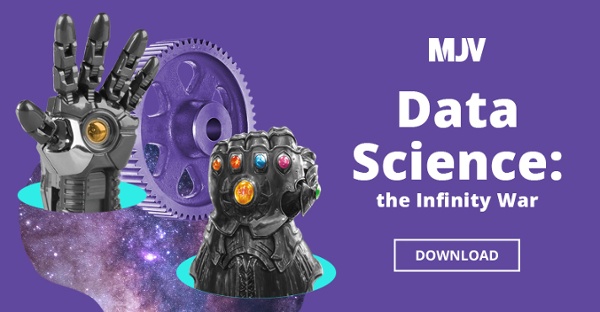Iron Man: the hero of wearables and IoT
We will fly along with Iron Man in the continuation of the Data Science post series: Infinity War. It’s not hard to see that the hero will represent IoT (Internet of Things), right?
*Iron Man image: Marvel/Disney
The hero in a can is so dependent on and passionate about his gadgets that he has long and intense conversations with them.
The Internet of Things is already a reality, but will be even more popular when we experience the connectivity leap of 5G. Autonomous cars and smart cities, for example, rely on the new connection to reach their full potential. The forecast is that by the middle of 2030, we’ll have a trillion devices connected.
Like Tony Stark, data scientists and organizations need to adapt to the opportunities and data volume of IoT. Next, we’ll show how Iron Man’s armor relates to the Big Data universe, and present the solutions offered by Data Science in the world of connected things.
Understand the relationship between Big Data and Iron Man armor
Throughout the saga of the Avengers, Tony Stark developed several armors. It is even nostalgic to remember his first version: the armor that was literally made of iron. Yet in Infinity War, his costume would be jealous of even the greatest geeks in the technology market: Mark L was all made up of nanomachines.
Stark presented 50 armor versions throughout his movie adventures – relying on the army he called in his third solo movie, of course. Let’s propose an exercise for fans of the Marvel saga: how about relating Big Data moments and the most famous Iron Man armor?
Mark I: Analogue Era
The first armor Stark developed, the Mark I, was totally analog. We can associate this armor with the moment we lived well before the connection to the internet: the Analogue Age. We were already experimenting with an increase in data and information with the media, but Big Data was just at the beginning of its exponential curve.
Mark III: Dial-up and Broadband
Jet propulsion, integration with JARVIS, videoconferencing, displays with information about the armor. With Mark III, Iron Man finally became the hero we know.
We can compare this moment of the hero with the dial-up and broadband era. At that point, we realized the real Big Data boom and the need to have solid strategies in this area.
Mark L: Digital Era and IoT
The armor used by Stark in the movie Avengers: Infinite War is a true luxury. With nanotechnology, it is divided into tiny fragments, which exchange information with the central system according to the will of the hero.
In short, all devices, accessories, tools, household items… in short, all things will be connected and will exchange data with each other – just like every nanomachine in the armor of the hero in a can. It’s a Big Data phase where data comes with a speed never seen before, which will be even more intense with 5G.
How does Data Science help companies achieve your IoT goals?
Is too much data a problem? Not for Iron Man. With the use of Machine Learning and the automation of data collection and analysis processes, the hero can always make strategic decisions quickly, coordinating his many gadgets to help him.
The team of data scientists also has a strategic position in the IoT universe. Let’s see how these professionals help your company achieve the goals in this area?
Performing the predictive and prescriptive analysis
Predictive and prescriptive analyzes are powerful tools, which are made even more viable by IoT. After all, with more things connected, we can extract more inputs for these types of analyzes – all will depend on our capacity and processing speed, something that data scientists can facilitate.
Large industries – using numerous devices and connected machines – already realize the value of this type of analysis and have Data Science strategies for this, optimizing the preventive maintenance of equipment, building strategic scenarios, among others.
Strategic and operational impacts
Data scientists can help you automate the entire operational part of the collection, processing and analysis of this data, especially with the use of Machine Learning solutions. This is the “shortcut” so we can automate a series of data-related processes.
Most importantly, it is these professionals who provide a more strategic perspective, setting goals for the analysis program, ensuring the feasibility of actions, and making the most of the value of the available data.
Development of IoT solutions
To close, we have our own development of IoT solutions. The team of data scientists can help at this time, as it not only has a concern for tool performance, but also the ability to extract data effectively.
IoT is already a reality for most organizations. As we have seen, it will be even more popular in our daily lives in the near future, with the advancement of 5G. Anticipating this reality is essential for your organization to remain at the technological forefront in the digital era.
Next Chapter: Nick Fury and Exploratory Analysis
“There was an idea to bring together a group of notable people and see if they could become something more. See if they could work together when needed. To fight in battles that we could never win.” Remember that phrase? Nick Fury is one of the most remarkable characters in the Marvel movies – it’s a shame he disappeared when Thanos snapped.
The SHIELD spy and original leader of the Marvel’s Cinematic Universe (MCU): Fury is the head that brought together all the heroes in the initiative that seeks to save the planet from any alien threat. We will talk about the relationship between the strategist and the exploratory analysis of Data Science in our next post.
Lost the beginning of our saga of posts? Then follow it from the beginning. Access our post Science Data: Infinity War!
Back
